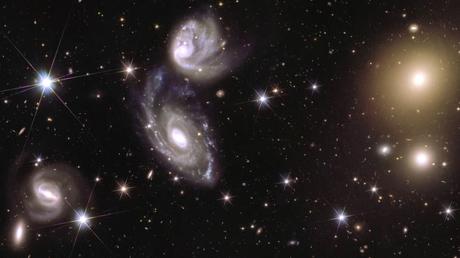Editor's note: A version of this story appeared in CNN's science newsletter Wonder Theory. To receive it in your inbox, register here for free.
Greetings, earthlings! I'm Jackie Wattles and I'm happy to be a new name bringing awe to your inbox.
I've been covering space exploration at CNN for almost a decade, and there's never been a more exciting time to follow discoveries in space and science. As researchers continue to strive to explore and understand the cosmos, technological advances are driving rapid developments in rockets, astronomical observatories and a wide range of scientific instruments.
Look no further than the missions racing to unlock dark matter and the mysterious force known as dark energy, both so named precisely because science has yet to explain these phenomena.
Astronomers have never discovered dark matter, but think it makes up about 85% of the total matter in the universe. Meanwhile, the existence of dark energy helps researchers explain why the universe is expanding - and why that expansion is accelerating.
Throughout the universe

Extraordinary new scientific instruments are delivering groundbreaking data, poised to reshape the way scientists view the cosmos.
A good example is the European Space Agency's wide-angle Euclid telescope, which was launched in 2023 to investigate the mysteries of dark energy and dark matter.
Euclid this week delivered the first part of a cosmic map - showing about 100 million stars and galaxies - that will take six years to create.
These stunning 3D observations can help scientists see how dark matter distorts light and warps space through galaxies.
Meanwhile, on a mountaintop in northern Chile, researchers from the U.S. National Science Foundation and Stanford University are preparing to power the world's largest digital camera at the Vera C. Rubin Observatory.
Excavated
In the mountains of Uzbekistan, a research team used lasers attached to a flying robot to uncover two cities that had been hidden and lost for centuries.
The anthropologists said they first mapped these forgotten medieval cities - located at a key crossroads of ancient silk trade routes - using a drone equipped with LiDAR, or light detection and ranging equipment.
As nature reclaims what's left of once-thriving civilizations, scientists are increasingly turning to remote sensing to peer through dense vegetation.
The images revealed two large settlements dotted with watchtowers, fortresses, complex buildings, squares and paths that tens of thousands of people may have called home.
Defying gravity
Remember the civilian astronauts who took a SpaceX capsule on a daring ride into a radiation belt and performed the first private spacewalk in September?
These exciting explorers, also known as the Polaris Dawn crew, spoke to CNN about some of the uncomfortable medical problems they experienced in space - a stark reminder that the human body was not designed for microgravity.
Blurred vision, nausea and vomiting were among the symptoms reported by the four-man crew.
But these problems were not unexpected. As part of the mission, the group conducted research that aims to understand and treat space-related diseases.
Long ago...
Researchers have long known of an 800-year-old story about a dead man being thrown into a well at Sverresborg Castle in Norway. The body's disposal was likely part of an attempt to poison the water supply during a gruesome military attack, the Sverris saga explains.
Now DNA analysis is allowing scientists to confirm the story in a stunning marriage of history and legend with science and technology.
Researchers initially uncovered the bones of an individual called "Well-man" near the castle in 1938. But only now has a research team, using advanced gene sequencing technology, managed to paint a clearer picture of who the man was - and the findings revealed an unexpected twist.
Fantastic creatures
At least two species of fireflies glittered in the night sky in the Mesozoic Era, according to new research.
That means dinosaurs may have witnessed the soft evening glow emitted by the bioluminescent insects.
Building on an earlier analysis of the first firefly species identified from that era, which was first described in 2015, a separate team of scientists examined another 99-million-year-old firefly trapped in tree resin.
This specimen, found in northern Myanmar in 2016, could help researchers better understand how fireflies evolved the ability to glow at least 100 million years ago.
Scientists are only now beginning to understand the evolution of these fascinating creatures because their soft bodies are so difficult to preserve in the fossil record.
Turn, turn, turn
Check out these can't-miss books:
- A giant meteorite estimated to be four times the size of Mount Everest struck Earth 3.2 billion years ago. The space rock boiled the oceans, but scientists now believe the aftereffects of the attack could boost conditions for life to thrive.
- Four astronauts riding home aboard a SpaceX capsule on Friday were unexpectedly sent to a medical facility in Florida. Three crew members were discharged, but one remained hospitalized with a "medical issue" that NASA did not disclose.
- The two Boeing Starliner astronauts were not on that mission. This is why they couldn't make the first flight back to Earth.
- Even if skygazers missed the peak of the Orionid meteor shower this week, there's still a chance to spot the annual celestial display and a host of other cosmic phenomena on the horizon.
Do you like what you read? But there is more. Sign up here to get the next edition of Wonder Theory in your inbox, brought to you by CNN Space and Science writers Ashley Strickland, Katie Hunt And Jackie Wattles. They find wonder about planets outside our solar system and discoveries from ancient times.
For more CNN news and newsletters, create an account at CNN.com
